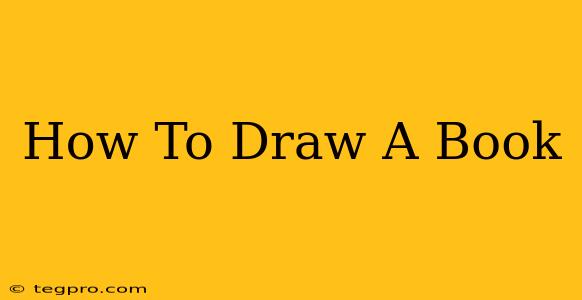So you want to learn how to draw a book? Whether you're aiming for photorealistic detail or a charmingly simplistic sketch, this guide will walk you through the process, providing tips and tricks for artists of all skill levels. Drawing a book might seem simple, but mastering its form and conveying its essence requires attention to detail and understanding of perspective.
Understanding Book Anatomy: The Foundation of Your Drawing
Before you even pick up your pencil, let's break down the essential elements of a book's structure:
- The Cover: This is the most visible part, often featuring a title, author, and sometimes striking artwork. Consider its thickness, texture (hardcover or paperback), and any unique design elements.
- The Spine: The backbone of the book, this crucial element shows the book's thickness and often displays the title. Drawing the spine accurately will lend realism to your artwork.
- The Pages: While you won't draw every single page, suggesting the bulk and the slight curve of the pages is vital for achieving a believable representation.
- The Edges: The visible edges of the pages contribute to the overall form of the book. Pay attention to how they interact with the cover and spine.
Step-by-Step Guide: Drawing a Closed Book
This guide focuses on drawing a closed book, a great starting point for beginners.
Step 1: Basic Shapes
Start with simple geometric shapes. Draw a rectangular shape for the main body of the book and a slightly narrower rectangle for the spine. These shapes will form the foundation of your drawing.
Step 2: Refining the Shapes
Now, refine the shapes. Add subtle curves to the edges of the cover and slightly round the corners. Remember, books aren't perfectly rectangular; they have gentle curves and softened edges.
Step 3: Adding Depth and Detail
Add shadows to create depth and realism. Observe how light interacts with the book's surfaces and use shading to highlight the curves and edges. Pay close attention to the spine; a subtle shadow along its edge can greatly enhance the realism of your drawing.
Step 4: The Finishing Touches
This is where you add the finishing touches. Lightly sketch in any text or design details on the cover. Consider adding a slight texture to the cover to suggest the material—paper, leather, or cloth. Erase any unnecessary guidelines.
Drawing an Open Book: A More Challenging Task
Drawing an open book adds another layer of complexity, requiring a strong grasp of perspective. Here are some key considerations:
- Perspective: The pages will appear to recede into space, creating a sense of depth.
- Page Curves: The pages will naturally curve inwards, creating a beautiful visual element.
- Shadowing: The shadows will be more intricate, needing careful attention to light sources.
Tips for Success: Mastering the Art of Book Drawing
- Reference Images: Use reference photos of real books to study their forms and how light falls on their surfaces.
- Practice Regularly: The key to improvement is consistent practice. Start with simple sketches and gradually increase the complexity.
- Experiment with Different Styles: Explore different drawing styles – realistic, cartoonish, abstract – to find what suits you.
- Use Different Media: Experiment with pencils, charcoal, pens, or even digital drawing tools.
Beyond the Basics: Adding Creativity and Flair
Once you've mastered the basics, try incorporating these elements to add unique touches to your book drawings:
- Different Book Types: Draw different types of books—hardcovers, paperbacks, sketchbooks, antique books—to showcase your versatility.
- Environmental Context: Place your book drawing within a setting—a library, a desk, or a cozy armchair—to create a compelling narrative.
- Adding Characters: Include characters interacting with the book, like a person reading or a character holding it.
Drawing a book might seem straightforward, but mastering its nuances will improve your overall drawing skills. By following these steps and practicing regularly, you'll be able to create stunning and realistic book illustrations. Happy drawing!

